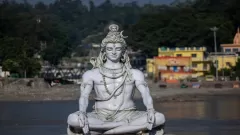Indian Railways History: How much do you know about Indian Railways?
Most of us must have traveled by train, but do you know about the journey on Indian Railways? If you are confused by this question of ours, then let us clear your doubts right now. Here we are talking about the story of Indian Railways, which started about 160 years ago and today India cannot be imagined without it.
Hardly anyone would have thought that the railway which was built by the British to transport goods, would become a lifeline for travel in India. At present, there is no match to Indian Railways which transports more than 2 crore passengers daily to their destination. Except the inaccessible hilly areas and islands, there would hardly be any corner of the country which would not be connected by rail.
India ranks fourth in the world in terms of rail network. America, China and Russia come at first, second and third place. Apart from transporting goods and passengers from one place to another, Railways is also the biggest employment provider enterprise in the country, where lakhs of people are employed.
From the pages of history
The history of the beginning of railways in India is about 200 years old. Initially the British thought of laying railway lines to transport goods to India and earn more profits. The first proposal was prepared in the year 1832 and the first railway line was constructed in 1835. In the year 1837, the first railway line was started in Madras, on which the first goods train was operated with the help of steam engine brought from England, that too for the transportation of granite. However, the first passenger train covered a distance of 34 kilometers between Bombay (now Mumbai) and Thane on April 16, 1853. This was the beginning of a new era of transportation in India. Since its early years, Indian Railways has witnessed unprecedented growth in several phases and has become one of the most important factors in national unity, prosperity, socio-economic transformation.
Indian Railways before independence
After the first passenger train ran in 1853, the Indian Railways expanded, but the operation of the railways was not under the control of any one organization. During that period, the ownership of railways was in the hands of various princely states of the country, railway companies, and the British government. Railway lines were then built primarily to transport agricultural and mineral resources from ports and rapid movement of troops. The first passenger train of Eastern India ran from Howrah to Hooghly in West Bengal on 15 August 1854.
Journey after Independence
After independence on 15 August 1947, railways were the only means of long-distance travel in the country. After independence, the government merged more than 42 separate railway systems to form the Unified Indian Railways. This was an important step towards establishing connectivity at the national level and strengthening the Indian economy. In the early decades after independence, the government focused on rehabilitating and modernizing the railway network, which had fallen into disrepair due to Partition. With the development of technology, steam engines gradually went out of service in India and were replaced by diesel and electric engines.
Expansion gained momentum in the 1980s and 1990s
The 1980s and 1990s were the most important decades for the expansion and modernization of railways in India. In the same decade, not only superfast trains were started for the convenience of passengers, but computerized reservation system was also started. While the country's first Shatabdi Express was introduced between New Delhi and Jhansi in 1988, air-conditioned third-tier and sleeper class coaches were introduced for the first time in 1995.
In 1996, Centralized Computer Reservation System was started in Delhi, Mumbai and Chennai. Along with this, many important projects including Konkan Railway, Delhi Metro upgraded the railway infrastructure. And now ambitious projects like the Mumbai-Ahmedabad High-Speed Rail (Mumbai-Ahmedabad Bullet Train) corridor have gained momentum, which will pave the way for the introduction of bullet trains in India. Along with this, the dream of reaching Kashmir Valley by train is also going to come true soon.
Indian Railways related to concerns
- Indian Railways is not just a means of travel, but is the lifeline of the country. Apart from carrying passengers and freight, it has played an important role in national integration, economic growth, employment generation and social inclusion.
- Indian Railways has been a powerful symbol of national unity. Millions of people choose it throughout the year for business, education, religious pilgrimage and cultural exchange. This train journey gives a glimpse of the diversity of the country.
- Indian Railways has also made an important contribution to the economic development of India. It is the backbone for the movement of coal, iron ore, cement, food grains and other commodities. The industry and agricultural sectors depend heavily on its services.
- Railways connect remote villages and towns with the national mainstream. It is the most convenient means of travel for the rich as well as the poor.
- Indian Railways is also the largest employment provider in India. The livelihood of millions of people is directly and indirectly linked to it.
Railways has also achieved many milestones in the field of Technology.
The progress that Railways has made in the field of technology since its inception cannot be appreciated enough. The journey that started with steam engines has today reached semi-high-speed trains like Vande Bharat and Gatimaan Express. And soon India's first bullet train will also be seen running on the tracks. With the development of technology, steam engines were first replaced by diesel engines and then electric engines came into service.
Computerized reservation and ticketing also contributed significantly to the technological journey of railways and transformed the entire process of rail ticketing. Travelers can now plan their long-distance journeys in advance. Online ticket booking (IRCTC) from the Railway's website and other websites has made the services more accessible.
Talking about passenger facilities, there were gradual but significant improvements in it too. These include better coaches, modern trains, better station facilities, food and drink arrangements, and many changes made to provide better facilities to the passengers. Railways also took many steps regarding security and also used modern technology. Indian Railways has upgraded its signaling systems, which has significantly helped in reducing accidents and enhancing passenger safety.























